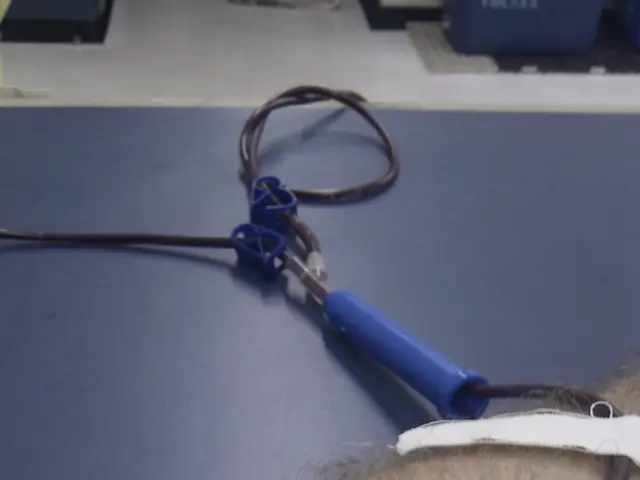Shaving-induced itchiness: Reasons behind its occurrence and methods to prevent it
In the pursuit of personal grooming, many individuals may encounter skin irritations such as razor burn, razor bumps, and folliculitis. To help prevent these issues, we've compiled expert guidelines for shaving various sensitive areas, including legs, pubic region, face, testicles, and scrotum.
### Pre-Shave Preparation
A crucial step in reducing the risk of skin irritation is proper preparation. Exfoliate gently a day or two before shaving using a mild scrub or chemical exfoliant like lactic acid. This helps remove dead skin cells and prevents hairs from getting trapped under the skin, reducing the risk of ingrown hairs and folliculitis.
Softening the hair and skin is also essential. Taking a warm or hot shower, or applying a warm, damp towel to the area for a few minutes, opens pores and makes hair easier to cut cleanly, minimizing irritation.
Applying a pre-shave oil provides extra lubrication and reduces friction between the razor and skin, particularly for sensitive areas like the pubic region, testicles, and scrotum.
### Choosing the Right Products
Using natural, moisturizing shaving creams or soaps that do not contain irritants such as alcohol, menthol, or heavy fragrances is recommended. Ingredients like aloe vera, glycerin, coconut oil, marshmallow root, or slippery elm are beneficial for soothing and protecting the skin during shaving.
Avoid dry shaving; always shave with plenty of moisture (wet shave). The water and shaving cream help the blade glide smoothly and reduce the chance of razor burn.
### Shaving Technique
Using a sharp, clean razor blade and replacing blades frequently is important to avoid tugging and skin irritation. Shave in the direction of hair growth initially, especially in sensitive areas like the scrotum and testicles, to minimize irritation and reduce razor bumps.
Use light, gentle strokes without pressing too hard, and avoid going over the same area multiple times. For delicate areas (pubic area, testicles, scrotum), consider using a razor designed for sensitive or tricky skin, or even electric trimmers for less irritation.
### Post-Shave Care
Rinse shaved areas with cool water to close pores and calm the skin. Apply a fragrance-free, soothing moisturizer or an aftershave balm containing natural calming ingredients like aloe vera.
Avoid tight clothing, especially around the pubic area and legs, to reduce friction and irritation. Wear loose, breathable cotton underwear to allow skin to heal and breathe.
If irritation or bumps develop, apply a warm compress with sea salt to soothe the skin and reduce inflammation.
### Additional Tips for Genital Areas
Be extra cautious to avoid nicks, as the skin here is very sensitive and prone to irritation and infections. Avoid harsh scrubbing or strong chemical products that worsen irritation. Practice safe grooming and hygiene to prevent infections that could cause folliculitis or sores. If sores, blisters, or severe irritation occur, consult a healthcare professional for proper diagnosis and treatment.
By consistently following these steps tailored to each body part's sensitivity, you can minimize risks of razor burn, skin irritation, and folliculitis effectively. Remember, everyone's skin is unique, so it's essential to find what works best for you.
[1] Mayo Clinic. (2020). Shaving: Tips for men. Retrieved from https://www.mayoclinic.org/healthy-lifestyle/mens-health/in-depth/shaving/art-20045565 [2] WebMD. (2020). Shaving: Tips for Women. Retrieved from https://www.webmd.com/beauty/makeup-skincare-tips/10-shaving-tips-for-women [3] American Academy of Dermatology Association. (2020). Shaving. Retrieved from https://www.aad.org/public/diseases/a-z/hair-removal-safety [4] American Academy of Family Physicians. (2020). Shaving. Retrieved from https://familydoctor.org/shaving/ [5] Healthline. (2020). How to Prevent Ingrown Hairs. Retrieved from https://www.healthline.com/health/how-to-prevent-ingrown-hairs#tips-for-shaving
Diabetes and macular degeneration are health concerns that may not be directly related to personal grooming, but maintaining good health-and-wellness practices can help manage them. Regular exercise, such as fitness-and-exercise routines and skin-care regimens, can aid in maintaining a healthy lifestyle.
Multiple sclerosis and HIV are chronic conditions that require medical attention. However, a healthy lifestyle, which includes proper nutrition, regular exercise, and stress management techniques, can help support the immune system, potentially easing symptoms.
Psoriasis, an inflammatory skin condition, may not necessarily be related to shaving, but certain skin-care practices, like using moisturizing products, can help soothe affected areas and reduce symptoms.
Spondylitis, a type of arthritis, is not directly related to shaving. However, staying active through fitness-and-exercise can help manage symptoms, as weight loss, particularly in obese individuals, can alleviate pressure on the affected areas.
AQ is a protein found in saliva and semen. It plays a role in the development of oral cancer and HIV transmission. Therefore, safe sexual practices and oral hygiene are crucial in preventing these conditions.
Type 2 diabetes is a common complication of obesity. Maintaining a healthy weight through diet and exercise can help reduce the risk of developing type 2 diabetes.
Hair loss, specifically androgenetic alopecia, can be influenced by genetics and hormonal changes. However, certain factors, like stress, poor diet, and certain health conditions like atopic dermatitis or alopecia areata, can trigger or exacerbate hair loss.
Atopic dermatitis, also known as eczema, can lead to dry, itchy skin. Proper skin-care, such as using gentle cleansers and moisturizers, can help manage symptoms and prevent flare-ups.
Dry skin can lead to various irritations, including itchiness, roughness, and cracking. Maintaining a consistent skin-care routine that includes moisturizing and exfoliating can help prevent these issues.
Depression and anxiety are mental health conditions that can impact overall health. Engaging in regular fitness-and-exercise, practicing mindfulness, and seeking support from healthcare professionals can help manage symptoms.
Migraines are recurrent headaches, sometimes accompanied by nausea, vomiting, and sensitivity to light and sound. Stress management, regular sleep schedules, and avoiding triggers can help lessen the frequency and severity of migraines.
During pre-shave preparation, it’s essential to exfoliate gently using a mild scrub or chemical exfoliant like lactic acid to remove dead skin cells, which can help prevent ingrown hairs and folliculitis.
When shaving sensitive areas like the pubic region, testicles, and scrotum, using a sharp, clean razor blade and shaving in the direction of hair growth can help minimize irritation and reduce razor bumps.




